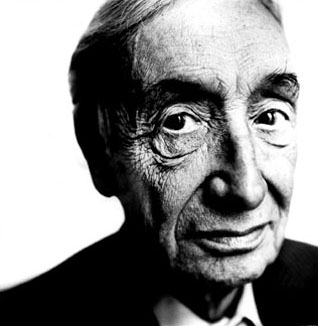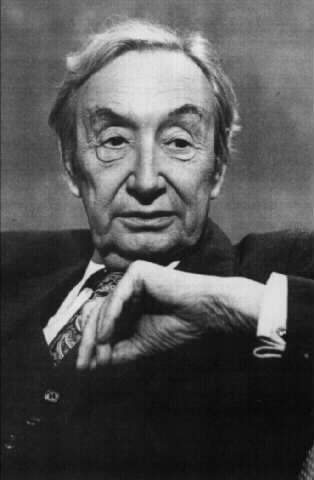<Back to Index>
- Philosopher Sir Alfred Jules Ayer, 1910
- Painter Andrei Petrovich Ryabushkin, 1861
- Chancellor of Germany Franz Joseph Hermann Michael Maria von Papen zu Köningen, 1879
PAGE SPONSOR


Sir Alfred Jules Ayer (29 October 1910 – 27 June 1989), better known as A.J. Ayer or "Freddie" to friends, was a British philosopher known for his promotion of logical positivism, particularly in his books Language, Truth and Logic (1936) and The Problem of Knowledge (1956).
Ayer was the Grote Professor of the Philosophy of Mind and Logic at University College London from 1946 until 1959, when he became Wykeham Professor of Logic at the University of Oxford. He was president of the Aristotelian Society from 1951 to 1952. He was knighted in 1970. Ayer was born into a wealthy family of continental origin. His mother, Reine Citroën, was from the Dutch-Jewish family who founded the Citroën car company in France. His father Jules Ayer was a Swiss Calvinist financier who worked for the Rothschild family. He grew up in St John's Wood, London. He was educated at Ascham St Vincent's Preparatory School and Eton, and then won a classics scholarship to Christ Church, Oxford. He served as an officer in the Welsh Guards during World War II, working for the SOE. He was a noted social mixer and womanizer, and was married four times, including to Dee Wells and Vanessa Lawson (mother of Nigella Lawson). Reputedly he liked dancing and attending the clubs in London and New York. He was also obsessed with sports, a noted cricketer, and a keen supporter of the Tottenham Hotspur football team. Ayer
was a well-known social figure in his time, and his circle of friends
included many famous people in public life, amongst them Cyril Connolly, Graham Greene, George Orwell, E.E. Cummings, Meyer Schapiro, Arthur Koestler, Bertrand Russell, Stuart Hampshire, Stephen Spender, W.H. Auden, Philip Toynbee, Isaiah Berlin, Hugh Gaitskell, Roy Jenkins, Michael Foot, Richard Crossman, Jonathan Miller, Angus Wilson, Alan Bennett, Alice Thomas Ellis, Jane Fontaine, Iris Murdoch, V.S. Pritchett, and Christopher Hitchens. In Language, Truth and Logic (1936), Ayer rejected atheism, as he understood it, on the grounds that any religious discourse was meaningless. However, in later years Ayer, abandoning strict logical positivism, did refer to himself as an atheist and stated that he did not believe in God. He followed in the footsteps of Bertrand Russell by debating with the Jesuit scholar Frederick Copleston on the topic of religion. Between 1945 and 1947, together with Russell and George Orwell, he contributed a series of articles to Polemic, a short-lived British "Magazine of Philosophy, Psychology, and Aesthetics" edited by the ex-Communist Humphrey Slater. Ayer was closely associated with the British humanist movement. He was an Honorary Associate of the Rationalist Press Association from
1947 until his death. In 1965, he became the first president of the
Agnostics' Adoption Society and in the same year succeeded Julian Huxley as president of the British Humanist Association, a post he held until 1970. In 1968 he edited The Humanist Outlook, a collection of essays on the meaning of humanism. He taught or lectured several times in the United States, including serving as a visiting professor at Bard College in the fall of 1987. At a party that same year held by fashion designer Fernando Sanchez, Ayer, then 77, confronted Mike Tyson harassing the (then little-known) model Naomi Campbell.
When Ayer demanded that Tyson stop, the boxer said: "Do you know who
the fuck I am? I'm the heavyweight champion of the world," to which
Ayer replied: "And I am the former Wykeham Professor of Logic. We are both pre-eminent in our field. I suggest that we talk about this like rational men". Ayer and Tyson then began to talk, while Naomi Campbell slipped out. In 1988, shortly before his death, Ayer wrote an article entitled, "What I saw when I was dead", describing an unusual near-death experience.
Of the experience, Ayer first said that it "slightly weakened my
conviction that my genuine death ... will be the end of me, though I
continue to hope that it will be." However,
a few days later he revised this, saying "what I should have said is
that my experiences have weakened, not my belief that there is no life
after death, but my inflexible attitude towards that belief". In
2001 Dr. Jeremy George, the attending physician, claimed that Ayer had
confided to him: "I saw a Divine Being. I'm afraid I'm going to have to
revise all my books and opinions." Ayer's son Nick, however, said that
he had never mentioned this to him. Ayer is perhaps best known for popularising the verification principle, in particular through his presentation of it in Language, Truth, and Logic (1936). The principle was at the time at the heart of the debates of the so-called Vienna Circle which Ayer visited as a young guest, and others including the leading light of the circle, Moritz Schlick were already offering their own papers on the issue. Ayer's own formulation was that a sentence can only be meaningful if it has verifiable empirical import, otherwise it is either "analytical" if tautologous, or "metaphysical" (i.e. meaningless, or "literally senseless"). He started work on the book at the age of 23 and it was published when he was 26. Ayer's philosophical ideas were deeply influenced by those of the Vienna Circle and David Hume. His clear, vibrant and polemical exposition of them makes Language, Truth and Logic essential reading on the tenets of logical empiricism – the book is regarded as a classic of 20th century analytic philosophy,
and is widely read in philosophy courses around the world. In it, Ayer
also proposed that the distinction between a conscious man and an
unconscious machine resolves itself into a distinction between
'different types of perceptible behaviour', an argument which anticipates the Turing test published in 1950 to test a machine's capability to demonstrate intelligence (consciousness). Ayer wrote two books on the philosopher Bertrand Russell, Russell and Moore: The Analytic Heritage (1971) and Russell (1972). He also wrote an introductory book on the philosophy of David Hume and a short biography of Voltaire. In 1972-73 Ayer gave the Gifford Lectures at University of St Andrews, later published as The Central Questions of Philosophy.
He still believed in the viewpoint he shared with the logical
positivists: that large parts of what was traditionally called
"philosophy" – including the whole of metaphysics, theology and aesthetics – were not matters that could be judged as being true or false and that it was thus meaningless to discuss them. In "The Concept of a Person and Other Essays" (1963), Ayer heavily criticized Wittgenstein's private language argument. Ayer's sense-data theory in Foundations of Empirical Knowledge was famously criticised by fellow Oxonian J.L. Austin in Sense and Sensibilia,
a landmark 1950s work of common language philosophy. Ayer responded to
this in the essay "Has Austin Refuted the Sense-data Theory?", which
can be found in his Metaphysics and Common Sense (1969).